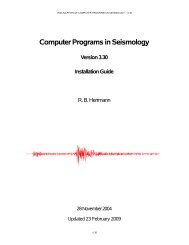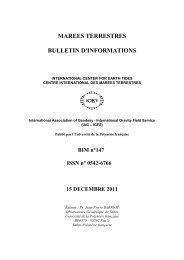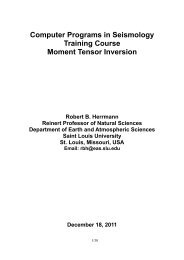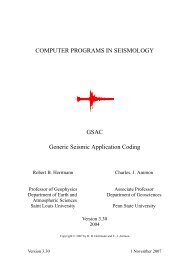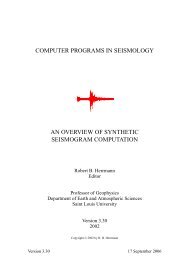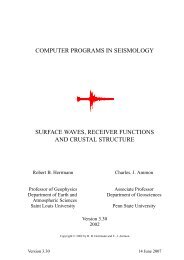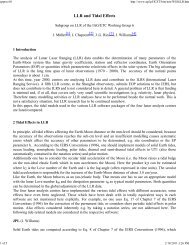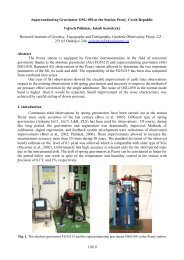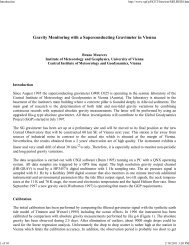3.04 Gravimetric Methods – Superconducting Gravity Meters
3.04 Gravimetric Methods – Superconducting Gravity Meters
3.04 Gravimetric Methods – Superconducting Gravity Meters
You also want an ePaper? Increase the reach of your titles
YUMPU automatically turns print PDFs into web optimized ePapers that Google loves.
100 <strong>Superconducting</strong> <strong>Gravity</strong> <strong>Meters</strong><br />
induce a gravity signal of several tens of nanometers<br />
per square second with a dominant beating between an<br />
annual term and the 435 day Chandler wobble.<br />
We now review some scientific studies in the various<br />
period ranges, as discussed in Figure 15. Section<br />
<strong>3.04</strong>.3.2 deals with the short-period seismic phenomena<br />
and other normal modes up to a 1 day period. In<br />
Section <strong>3.04</strong>.3.3, atmospheric effects on gravity are<br />
described while tidal contributions (fluid core resonance<br />
effect, linear and nonlinear ocean loading) are<br />
discussed in Section <strong>3.04</strong>.3.4. Section <strong>3.04</strong>.3.5 deals<br />
with nontidal ocean loading, hydrology contributions<br />
are covered in Section <strong>3.04</strong>.3.6, and Section <strong>3.04</strong>.3.7<br />
covers Earth rotation and polar motion effects. Section<br />
<strong>3.04</strong>.3.8 deals with tectonics, and Section <strong>3.04</strong>.3.9 considers<br />
the problem of the calibration/validation of<br />
gravity satellite data with SG ground observations.<br />
Finally, Section <strong>3.04</strong>.3.10 suggests new projects, especially<br />
using SGs in regional arrays.<br />
<strong>3.04</strong>.3.2 Seismic and Subseismic Signals<br />
Investigation with SGs of the seismic normal modes<br />
excited by large earthquakes has led to some new and<br />
impressive results, due primarily to the low noise<br />
levels of SGs at periods longer than 500 s, as indicated<br />
in Figure 17 (Rosat et al., 2003a). At periods<br />
longer than 1000 s, the best SGs have lower noise<br />
than the worldwide seismometer limit NLNM (new<br />
low noise model, Peterson, 1993); noisier SG stations<br />
cross the NLNM at longer periods (4.2 h for the<br />
station Be, for instance). This extensive compilation<br />
of all the GGP stations extends earlier results from<br />
just a few SG stations but which already were convincing<br />
in terms of low noise (Banka and Crossley,<br />
1999; Van Camp, 1999). In addition, metrological<br />
comparisons between SGs and broadband seismometers<br />
(Freybourger et al., 1997; Hinderer et al.,<br />
2002b), as well as between AGs and SGs over a<br />
large spectral range (Crossley et al., 2001; Francis<br />
et al., 2004), have demonstrated the excellent characteristics<br />
of SGs.<br />
Of recent large earthquakes, the 2001 Peru event<br />
of magnitude M ¼ 8.4 strongly excited the long-period<br />
seismic modes, and significant observations were<br />
made by the GGP network. In particular, the fully<br />
split 0 S 2 multiplet (with five individual singlets),<br />
which has been rarely visible on a single instrument,<br />
could be fully analyzed from the Strasbourg C026<br />
instrument (Rosat et al., 2003a) but was also present at<br />
other SG stations.<br />
The most important new result was the detection<br />
of the overtone 2 S 1 (see Figure 18), which is an<br />
elastic mode, unlike the Slichter triplet 1 S 1 whose<br />
PSD relative to 1 (m s <strong>–</strong>2 ) 2 Hz <strong>–</strong>1<br />
<strong>–</strong>130<br />
<strong>–</strong>140<br />
<strong>–</strong>150<br />
<strong>–</strong>160<br />
<strong>–</strong>170<br />
<strong>–</strong>180<br />
<strong>–</strong>190<br />
<strong>–</strong>200<br />
<strong>–</strong>210<br />
<strong>–</strong>220<br />
<strong>–</strong>230<br />
10 <strong>–</strong>5<br />
NLNM<br />
subseismic seismic<br />
1<strong>–</strong>6h<br />
1000 s<br />
10 <strong>–</strong>4 10 <strong>–</strong>3<br />
Hz<br />
Be<br />
Bo<br />
Br<br />
Ca<br />
Cb<br />
Es<br />
Ky<br />
Mo<br />
Ma<br />
Mb<br />
Me<br />
Po<br />
St<br />
Su<br />
Sy<br />
Vi<br />
Wu<br />
Ba<br />
We<br />
10 <strong>–</strong>2 (CD029)<br />
We<br />
(T103)<br />
Figure 17 Noise levels of the SGs from the GGP network. Reproduced from Rosat S, Hinderer J, Crossley D, and Rivera L<br />
(2003a) The search for the Slichter Mode: Comparison of noise levels of superconducting gravimeters and investigation of a<br />
stacking method. Physics of the Earth and Planetary Interiors 140: 183<strong>–</strong>202, with permission from Elsevier.




